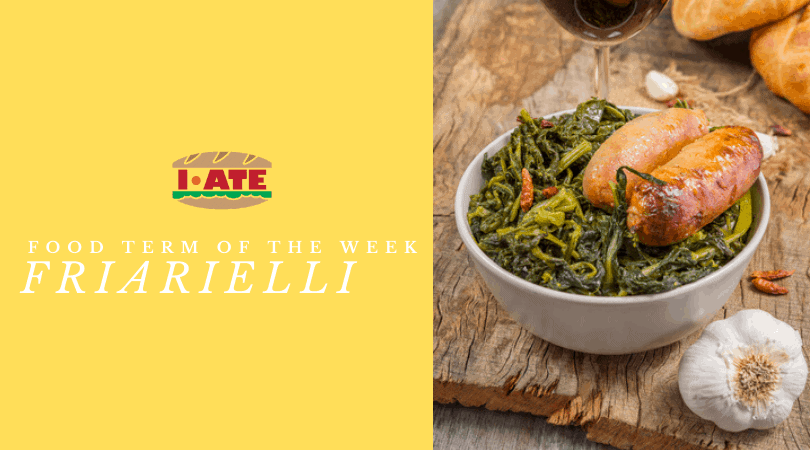Italy offers a wide range of vegetables throughout its twenty regions and many of them can have a different name according to their region of origin. This is the case, for example, with friarielli, as we call it in Campania. It is a green cruciferous vegetable characterised by its bitter tasting stem and leaves. In other regions people call it rapini (Tuscany), cime di rapa (Apulia), broccoletti (Rome), mazzareddi (Sicily) or pulezze (Valdichiana). However, never try to compare it to any other kind of similar greens, because “friarielli is just friarielli!”
In Naples this food is actually very widespread and beloved; recently even a hymn of praise has been written by Francesco Andoli, deputy editor of the online newspaper Identità Insorgenti. In this short dialogue someone tries to define friarielli by comparing it to something else, but every definition turns out to be unsatisfactory to the other speaker who concludes with a sort of personification of “the friariello” (singular for friarielli): “The friariello doesn’t look like anybody. The friariello doesn’t speak Italian. The friariello is native and self-sufficient. The friariello is Neapolitan and the sausage… knows it all!” (translated from Neapolitan). This reference to the familiarity between friarielli and sausages is not random, for if it is true that friarielli can be cooked and eaten with meat in general, the combination sausages-friarielli is considered to be a perfect culinary marriage, something almost sacred. Indeed, as a traditional Neapolitan saying goes, “’a sasiccia è ‘a mort’ d’e friarielli” (literally meaning “sausage would die without friarielli”), which underlines that they are meant for each other.
For the reader’s sake, here follows a traditional recipe reported in The New York Times, which shows the extent to which this typically Mediterranean food is now also well known overseas:
Broccoli Rabe (Friarielli)
Time: 20 minutes
4 tablespoons extra virgin olive oil;
2 or 3 garlic cloves, peeled and slivered;
3 or 4 dried chilies;
2 pounds broccoli rabe, trimmed of stalks over 1/8 inch thick, washed and left wet;
Salt and pepper.
- Put oil in a skillet over medium-low heat and add garlic and chilies. When they sizzle and garlic begins to color, add broccoli rabe all at once.
2. Cook, stirring occasionally, until broccoli rabe is very tender, 10 to 15 minutes; if stalks are thick, you may have to add a few tablespoons of water to let them cook all the way through, but keep this to a minimum. Remove chilies before serving, if you like.
Yield: 4 to 6 servings.
(The New York Times, Aug. 29, 2007)
Among the other European countries, friarielli (or something like it) can be also found in Portugal (grelos de nabo) and in the Galicia region of northwestern Spain, in particular in the town of As Ponte where every February the so-called Feira dos grelos is celebrated. Even in China, kai-lan (芥兰) could be considered the brother or the sister of friarielli. Well… ok, maybe its cousin!

As for the etymology of friarielli, there are two different schools of thought. On the one hand, the term could derive from the Castilian expression frio-grelos (winter broccoli); on the other one, it could simply stem from the Neapolitan verb frijere (to fry). The latter is very likely to be true, also because, even though some national and international recipes tell us to boil or blanch it, the only possible way to cook friarielli is just by sizzling it! But be careful, because just this aspect, linked to the verb “to fry” (friggere in Italian), leads many people to confuse friarielli with friggitelli. The latter refers to small sweet peppers which are generally fried and eaten with meat or pasta; whereas friarielli …is just friarielli.
So the Friariello, almost always accompanied by its faithful consort the Sausage, is definitely the king (or the queen, if you want) of the Two Sicilies’ vegetables. However, despite its irresistible and unique flavour, the Friariello has a spiteful disposition and very often it is ready to sneak into our teeth and ruin our best smiles! But we can forgive it, because friarielli… is friarielli.
Sources:
https://www.napolifilmfestival.com/nff/it/node/4480
https://fiumiamare.home.blog/2019/03/12/elogio-breve-al-friariello/
https://www.finedininglovers.com/article/what-are-friarielli-how-do-i-cook-them
http://www.bellanapoli.fr/decouvrir/societe-art-de-vivre/gastronomie/friarielli/
https://www.nytimes.com/2007/08/29/dining/292mrex.html
Russo Roberto, Fioretto Natale, Che cavolo vuoi?: Ricette del cavolo, Graphe.it edizioni, Perugia, 2015.
https://afoodobsessionblog.wordpress.com/tag/friarielli/
https://www.the-pasta-project.com/pasta-with-friggitelli-peppers-pancetta/
https://elisabethscotto.com/2016/03/17/les-friarielli-toute-mon-enfance-dans-un-bouquet/
https://www.sbs.com.au/food/recipes/orecchiette-broccoli-rabe-orecchiette-con-cime-di-rapa
Written by Antonio Leo, PhD student in “European Languages and Specialized Terminology” at the University of Naples “Parthenope”.

